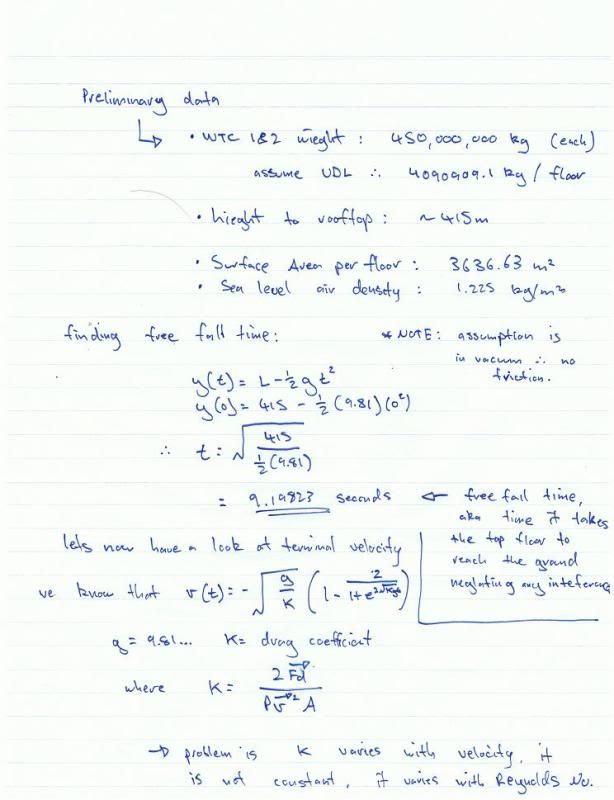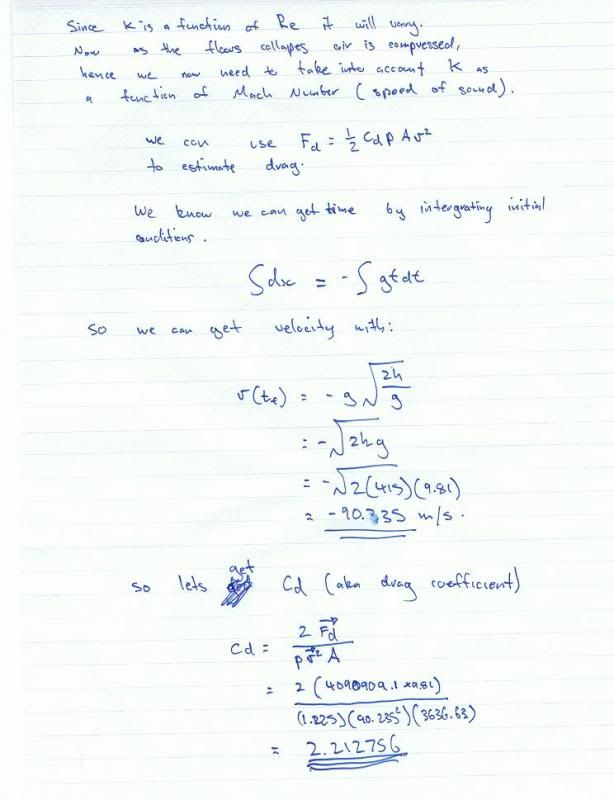
Originally Posted by
BJJ

I do not believe in BS either, that is why I use my brain to develop thoughts!
Once marcus asked me in my interview:
marcus300: If there is one thing in the world you could change, what would it be?
BJJ: Ignorance. (Those who rule us can keep doing that because ignorance is well spread-out).
You are the perfect example of those who I was referring to (no offence).
I am going to explain you now, why those sckyscrapers could not be molten in that way, apologizing for my English but I am not a native speaker:
The problem in itself is of a simplicity even disarming, especially for those who have an understanding of physics, enough a little. We just need to shape the free fall of a material body subject, in addition to the gravity, even to the resistance on the part of the material that surrounds the subject in question, so the air.
1&2 The material body p is dropped from a height L compared to the ground (equation of motion).
Where d = 9.8 m/s*s (the well-known acceleration of gravity) and k is a parameter called aerodynamic drag. In the case is k = 0 the solution is universally known.
3&4 A little less known is the solution to the [1] in the case in which the strength of the material (which may be a gas, a liquid or even a material in powder) is not negligible. To tackle the equation (which is of the second order and especially not linear due to the presence of the squared period) agrees reducing it to a system of two equations of the first order. The equation in unknown v is resolved in a classic way by separating the variables.
5 By integrating the [5] with the condition y(0)=L is finally obtained the solution.
6 At this point we need to specify something relatively to the constant k, which dimensionally is expressed in units 1/m. In any aerodynamic treaty you can find the formula that provides the aerodynamic drag (kg) of an object that moves in the air with speed v.
In which:
r, is the aerodynamic drag expressed in kg
ro=.125, is the density of air to share 0
sr, is the reference area in square metres
cd, is the coefficient of aerodynamic drag (typical value .2-.5]
7 From the time that in fall to constant speed the aerodynamic drag equals the weight of subject, with appropriate replacement in [6] it comes to the following value of k.
8 Since p the weight of subject in kg, assuming for simplicity sr = 1 square metre and cd = .5 (the subject is not efficient) for k it can be expected the result.
This means that for a subject with section equivalent of a square metre and heavy 30 kg is k = .01, while for a subject with the same section equivalent heavy instead 60 kg is k = .005.
Now, if we could go back in time and place ourselves on the last floor of one of the two towers [110 plans, 415 metres of height] and drop from there above three objects, the first very heavy, with very section aerodynamics, the second with one square meter section of 60 kg heavy, the third, with the same section and heavy 30 Kg; using the formulae found previously we obtain that:
the first object arrives to ground zero in 9.15 sec.
the second object arrives at ground zero in 12.75 sec.
the third subject arrives to ground zero in 15.55 sec.
- Let's see see now the movie of the collapse of the South tower. From the first moment of the collapse the last floor of the South tower has arrived to the ground in about 11 seconds. In other words just one or two seconds more than if he had been in conditions of free fall in a vacuum.
- Now the North tower. From the first moment of the collapse the last floor of the North tower has arrived at ground zero in about 15 seconds. The time of falling in this case was superior, but still comparable with the time of fall of an object in free fall hindered by the mere resistance of the air.
The official hypothesis (fall for domino effect or if you prefer effect pancake) has no meaning.
In this case, the time of fall of the towers had to be in the order of 98 seconds, not 11 or 15, but 98. The difference is certainly not negligible.
Let's see now in practical terms that things to me personally, I would like to know by supporters of the truth Journal. All the calculation now displayed served to prove without a doubt a given incontrovertible: the upper floors of the towers are precipitated experiencing the resistance of the only air. What I want to know is simple: as may have the core of steel of the towers volatilized instantly leaving the upper floors literally suspended in the air? That happens only and exclusively in controlled demolitions, when the explosives, detonating, destroy all the structures of support of the planes at the same time. In a spontaneous collapse, instead, of course they yield before the most damaged, and only after they yield also the other support facilities, which are found to have to bear excessive weight and ultimately collapse. This would have happened in particular in the case of the collapse of the South tower, which had been affected on the side, and not in the center, and it was therefore found itself with the support structures damaged in one hand and intact in the other, and is instead collapsed in perfect vertical way and in the space of just 11 seconds or so.
Fall time so short and collapse so accurate and are therefore vertical explained only admitting that there has been use of explosives in the collapse.
Hope I was clear but mostly UNDERSTOOD.





 Reply With Quote
Reply With Quote










